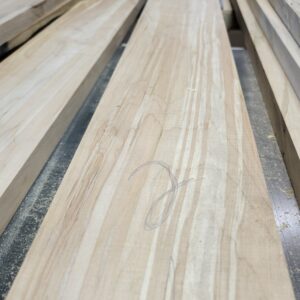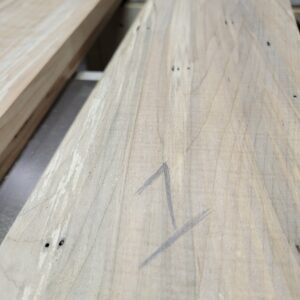Can anyone help identify this wood? It was sold to me as ambrosia maple but it appears to be 2 different kinds of lumber or species. The stuff marked with a number 1 has the tell tale holes from the ambrosia Beatles but it doesn’t quite look like ambrosia to me. It’s also a fair bit softer and lighter in weight than the other stuff. The lumber marked with a number 2 looks more like ambrosia and is very heavy and hard but doesn’t have those beatle holes. I dont have any end grain photos at the moment, but the end grain certainly shows no signs of it being spalted. This has me confused, I’ve done a ton of research but that was just a rabbit hole that yeilded nothing useful. I’d like to build and sell a table out of it but if I list it as ambrosia, I’d like to be sure that’s in fact what it is. Thanks.
Discussion Forum
Get It All!
UNLIMITED Membership is like taking a master class in woodworking for less than $10 a month.
Start Your Free TrialCategories
Discussion Forum
Digital Plans Library
Member exclusive! – Plans for everyone – from beginners to experts – right at your fingertips.
Highlights
-
Shape Your Skills
when you sign up for our emails
This site is protected by reCAPTCHA and the Google Privacy Policy and Terms of Service apply. -
 Shop Talk Live Podcast
Shop Talk Live Podcast -
 Our favorite articles and videos
Our favorite articles and videos -
E-Learning Courses from Fine Woodworking
-
-
 Fine Woodworking New England Event
Fine Woodworking New England Event -














Replies
Ambrosia maple, it does not have to be sugar maple, could be other wood from the same family but softer, we call it « plaine « in French.
Spalted wood comes from a fungus that decays the wood, and causes the distinctive discoloration. It may or may not have insect holes. The piece that's lighter might simply have decayed more, getting softer and lighter, and had insects. The heavier piece decayed less.
Pictures of wood are hard to decipher. They both look like spalted maple to me though. But other species can be spalted as well.
There is no ambrosia maple species. Various trees in the maple (Acer genius) get infected with a rotting fungus. The ambrosia fungi is found in association with ambrosia beetles. The beetles bore into the trunk of the tree, bringing with them the ambrosia fungi, which subsequently stains and discolors the surrounding wood. The discoloration can be very similar to spalted or “rotting” maple although with ambrosia, the discoloration is centered around the boring paths of the beetles, and their entrance holes can usually be seen. You could have lumber cut from different parts of the same tree since rot fungi can travel some distance from the initial infection site. (From a retired forester). Hopefully this helps.
"Ambrosia" is not a maple species, it is a descriptive (or marketing) term for the coloring that results from spalting. If the coloring is there you can call it ambrosia. I guess nobody wants to buy partially decayed and fungus-ridden maple furniture. Go figure.
Someone asked me what the difference was between fungus ridden, partially rotted maple and Ambrosia Maple. I said about 8 bucks a board foot.
Ambrosia maple, as noted above, is not a wood species. The wood is usually soft Maple that an Ambrosia beetle has bored a hole into. The beetle carries a fungus with it into the wood where it then forms a colony which results in the "stained" areas. The holes are a good indication of the infestation.
I love using the wood, it has a lot of character. But I'm not sure exactly what kind of wood you have there.
I wish Tiger Maple and Birds Eye maple would be species too but you have to cut down the tree to discover. Nevertheless, When I go through the pile at the yard, I select pieces that have the figure I have in mind for the project being made, usually lots of contrast but in the same pile of wood, some pieces have just a light discoloration, I leave them for others. I just brought back over 100 bd ft of it (with some birds eye maple and red oak for two other projects) to match the expresso machine table I built a few months ago :
Give us the wider view with the giant radial arm saw at the other end of the espresso bench! I'm thinking about a small coffe press for my shop.
That whole coffee thing is a fad. Pretty much run its course.
Built in Knock box for your press :
The expresso bench is at the local café but here it is :
I was certain it was the same table. Overcaff and RAS, what could possibly go wrong?
I know ambrosia maple is not a species. Nor is tiger, nor is spalted, etc. That's not the context I was going for. I was just thinking that the two different kinds of lumber I have here are so different that maybe they were different species of tree altogether. As in maybe not even maple, since the silvery stuff is so light and very soft. Barely harder than pine.
Still, I enjoyed reading the discussion. I'd never heard of ambrosia, fungus maple. Spalted lumber is a kind or risk-reward experience. A little may yield an interesting feature without much loss in fiber strength - a bunch of spalting just yields rotted wood which just is compost for the garden.
This forum post is now archived. Commenting has been disabled